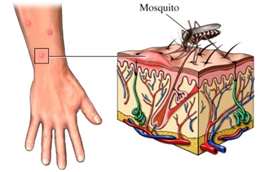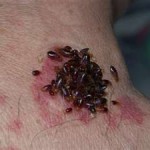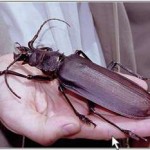Bug bites and stings usually are just nuisances. They bring momentary alarm, temporary discomfort and pain, but no serious or lasting health problems. But on occasion, they can cause infections that require treatment and allergic reactions that can be serious, even fatal.
Parents should know the signs of an infection or allergic reaction, and when to get medical attention. Inform all caregivers if a child has any history of complications so they know what to do in the event of a bug bite or sting.
Mosquito Bite
 Mosquitoes require blood for food and nourishment and will feed off humans and other warm-blooded animals. Mosquito bites occur around the summer months mainly because there is a higher rate of people outdoors, thus giving the mosquito more opportunity to feed. Bites are prevalent during the evening. Only the female mosquito will bite, resulting in itching, redness and swelling. Mosquito bites are becoming a significant health concern as some mosquito species act as vectors for fatal diseases and infections such as West Nile and Highland J virus.
Mosquitoes require blood for food and nourishment and will feed off humans and other warm-blooded animals. Mosquito bites occur around the summer months mainly because there is a higher rate of people outdoors, thus giving the mosquito more opportunity to feed. Bites are prevalent during the evening. Only the female mosquito will bite, resulting in itching, redness and swelling. Mosquito bites are becoming a significant health concern as some mosquito species act as vectors for fatal diseases and infections such as West Nile and Highland J virus.
Bed Bug Bite
 Bed bugs are blood-feeding, parasitic insects. They mostly feed off human blood and need a warm body around in order to survive. The name bed bug originated from the fact that these bugs would feed during the night and then hide inside the mattress and box spring until the next feeding.
Bed bugs are blood-feeding, parasitic insects. They mostly feed off human blood and need a warm body around in order to survive. The name bed bug originated from the fact that these bugs would feed during the night and then hide inside the mattress and box spring until the next feeding.
The main cause of infection is through clothing, luggage or infested dwellings near the home. Although they do not transmit disease, they can cause allergic reactions and psychological problems.
A bed bug starts by injecting its saliva in the person’s skin. This relaxes the muscle and the bug will then feed. The saliva will cause that particular area to become inflamed and swollen. The appearance of the bite will vary. Usually the bug feeds in areas close to the arms and upper torso.
Scabies
Scabies is caused by small parasitic bugs smaller than 3 mm in length that burrow under the skin. The bites are caused by hatching of the mites and by its fecal matter. Bites and sores are prevalent around the wrists, joints, and in between the fingers. The bites will itch and swell. Thin lines or barrows are also prevalent near and around the bites.
Beetle Bites
Beetles are common arthropods. Although beetles do not usually bite people, some beetle species, such as the Titanus giganteus, one of the world’s largest beetles, can inflict serious and painful bites. Another beetle species, the Blister beetle, can also inflict serious pain from their bites. When a beetle bites, it releases a toxin into the skin. This toxin reacts with the skin and irritation, reddening and swelling will result.
Fire Ant Bites
Fire ants are one of the few species of ant that can both bite and sting. Unfortunately, they also are aggressive. Fire ants grasp the skin with their mouths and then sting with their abdomens in a circular motion. Fire ant bites start off as red, raised areas, but they eventually turn into liquid filled bubbles. Swelling is usually there, but mild. If you’re allergic, the swelling may be more severe.
Spider Bites
Spiders aren’t technically insects, but they are responsible for a large percentage of swelling bites. Spider bites can vary greatly because there are so many different kinds of spiders. Generally speaking, spider bites have two very small puncture holes with a red, swollen area surrounding them. Poisonous spider bites will typically ulcerate at the bite site. A larger area around the bite is red and swollen if you’re bitten by a poisonous spider. Regardless of the type of spider, swelling is usually immediate and goes away three to five days later. Some poisonous spider bites, such as a brown recluse spider bite, may take longer to heal, or require medical intervention.
Chigger Bite
Although I have mentioned about chiggers in this article, it is to be known that these are not insects but arachnids. Here, bug bite identification begins with inspecting the areas around the waist, ankles, or in warm skin folds. These are the areas where they lay their bite and cause wounds in the form of small raised red lesions. Itching does occur, but after several hours of the bite. That is why the victim may not be aware of a chigger bite. If you have ever come in contact with poison ivy or oak, then it would be easy for you to identify the symptoms of a chigger bite, as they are similar to those of the ivy.
